Author: Zsolt Romos
DOI: 10.5434/9789634902263/17
Abstract
This study examines ways to redefine movement mechanisms in musical instruments and to develop skills in a more complex way in addition to developing correct movements, while also taking into account individual characteristics in everyday practice, especially for the flute. The study summarizes information about the anatomical and physiological background of motion development for music teachers. It also introduces extended flute technique with exercises to improve student movement coordination. Such techniques can also assist teachers in recognizing and applying the phases of motion learning.
Keywords: dimension of movement mechanisms, movement development, flute technique
Introduction
Invariably, learning begins with motion, in particular with the correct formation of connections between movements. Our neural pathways and perceptions must be created, adjusted, and embedded through attempting numerous movement patterns, which should also be aligned with our innermost feelings. But how does this happen? It is worthwhile to observe as to how children learn to control and, subsequently, finetune their movements from early infancy. Large movements become gradually finer as infants experience the joy of movement and discover their arms and legs. Initially, babies perceive as little as the action of holding out their hand in the adequate direction as a positive experience. Later, they form a fist and then learn to hold a toy with it. As the movement of separate fingers becomes increasingly distinct, infants are able to grasp even small objects. Movements become differentiated. At first, the pencil is grasped with the palm and is used for “scribbling”, which later transforms into subtler shapes and shading. The road to Guernica is indeed long… It is important to understand that children have acquired several basic movements by the time they start to learn to play instruments but have yet to learn many which are highly necessary in the given field.
Nowadays, children encounter increasingly fewer movement patterns as they are forced to move less than it was customary before. Changes in the culture of movement and play have an enormous effect on how music is taught. It is easy to observe how many fundamental movement patterns which posed varied challenges to our body have ceased to be part of our lives. Certain exercises such as rhythmic nursery rhymes or rhythmic games could even contribute to internalising basic rhythms. This would happen independently of music education and, more importantly, before it. What is more, children’s attention has also become less focused among the constant and rapid changes of our time. I have been teaching for 27 years and possess first-hand experience of such transformations. In music pedagogy, a gradual model with systematic increments must be followed, which proceeds from large movements through small ones towards truly subtle motions; from crude movements to goal-oriented fine motor skills. It is crucial for 6 to 8-year-olds to face mental, spiritual, and physical challenges which correspond to their capacities with modest increments. Initially, the focus should be on the activity itself, while ornaments and complementary elements should be included only gradually. The order of it is important because it is decisive for children’s emotions whether they need to worry already at the beginning or they can play happily in a comforting and safe environment with only gradual modifications.
Regrettably, music education is often only successful at teaching traditional “instrumental play” and instrumental techniques, due to its professional orientation. If we examine the problem closely, however, we arrive at the following questions: how to teach?; how to participate in a “personal development programme” which enriches and shapes our students’ personality individually by integrating our feelings into it, which forms their tastes and values, which establishes internal harmony, and which also aims to create, control, and confidently utilise movements and movement sequences?
As I see it, teaching requires the presence of various factors at the same time, in individually tailored proportions. To list the most essential elements, we, teachers, must develop students’ ability of perception, fine-tune and direct their musical attention, educate them to detect complex relationships, while teaching them how to approach a problem holistically, how to understand the relation between the part and the whole, how to analyse and synthesise, how to develop the ability of musical imagination and musical impression, or how to separate the important from the unimportant. What is more, we need to make students strive for creativity, for logical thinking, for consistency, for a healthy sense of responsibility and accountability, for precision, for harmony between thoughts and actions, for readiness to make decisions, as well as for the demand and sensitivity for quality. Apparently, the list is quite long. There is a risk of setting disproportionate expectations if we are not careful and attentive enough and do not manage to find the appropriate and individually tailored proportions and pace in dealing with such abilities, competencies, and skills.
Indeed, many teachers often set requirements which are difficult to meet without losing the uplifting joy of playing and without developing anxiety and distress throughout the learning process. Consequently, it is instrumental to evaluate responsibly the attitude, intellectual approach, knowledge, and material which are necessary and comprehensible for all children. It follows that the emphasis should be placed on quality and gradual progress rather than quantity to achieve a stable, genuine, and verifiable depth of knowledge. In other words, we need a methodology which educates, directs, and teaches from an interdisciplinary approach. This can be used as a “common root”, a foundation in the spirit of directing attention towards the whole. Through integration, differences are revealed by finding and understanding interdisciplinary “intersections”.
Music teachers’ role is even more pronounced as they can aid children actively, with the tools of emotional and aesthetic education, not just to improve musical abilities and skills but also to shape a harmonious, emotionally rich, and creative personality, which could occur as a result of positive experiences in relation to playing and creative work. We must ask: is instrumental pedagogy able to channel mental, intellectual, neural, and physical abilities in the right direction, in an individually tailored manner, without using the usual (and often overused) standards? Are we able to assess children’s physical endurance, understand their general well-being, and create emotional, physical, and neural harmony and balance for them? Besides teaching the appropriate movement sequences, can we redefine movement mechanisms by connecting perceptions about the temporal nature of music with the ability to express individual emotional surplus? Which methods and tools are available to enhance human traits and abilities in such a way?
My research in the field is based on the collection and review of Hungarian and international methodologies, studies, and papers, as well as on consultations and correspondence with outstanding professionals of other disciplines. In particular, this study considers the methods of implementing complex flute techniques in everyday practice. In addition, it also explores the possibility of establishing an “engaged” and active connection between movement mechanisms and instrumental perceptions, which means that goal-oriented movements regarding the instrument are formed and gradually adjusted in a playful manner. The study also contains analyses about the following topics: the structure of the neural networks for muscle groups which are the most affected by instrumental play (muscles of the lips, hand, arms, and respiration); the method through which a coordinated and simultaneous cooperation may be achieved between separately located yet functionally related, interconnected, and mutually governed muscles; and the accurate control over tension and release.
The first section of the study summarises the anatomic and physiological background of motor development for music teachers, which is crucial knowledge for their pedagogical work. I especially thank Edina Szegeczki, DMD, medical professional and flautist for her help in relation to this topic. The second section introduces extended flute techniques. The goal of such exercises is to establish a stable foundation for the motor control of the musical activity; to create automatic movement units; to explore, learn, and master novel ways of producing sounds and extended technical elements; to implement these effects and perceptions with classical embouchure; and to incorporate the elements and methods of extended flute techniques into the process of establishing basic instrumental skills. The exercises in the study help students internalise the appropriate and sparing movement patterns and improve their motor coordination, while also assisting teachers in identifying and utilising the three stages of motor learning.
The study attempts to bring music teachers closer to the knowledge which they can use as a foundation for incorporating recent scientific research and practices into music education, which ought to provide answers for contemporary challenges. Performance as a musician is largely dependent on an efficient and well-designed work method, on a comprehensive analysing activity, and on practice. An important pillar of the current Hungarian music education is its ability to provide the respective advanced method from primary to tertiary levels.
The Anatomic and Physiological Background of Motor Development and Its Importance in Music Education
The role and importance of motor development and motor improvement in forming one’s personality cannot be understated. However, motor development is a highly complex process. While the operation of a mechanical structure, its coordination, and its necessary conditions can be understood relatively easily, we seldom get the opportunity to grasp and approach the functioning of our own body or nervous system in the same manner. It is amazing to discover the complexity of the world, our motions, and our personality. Each of these constitute a system which adapts, moves, breathes, and acts in accordance with internal and external transformations.
At the introductory level, our instincts lead us to consider only the body and its movements. The way in which movements of bones, limbs, body parts, and joints are executed can be affected at this level. However, the decisive step occurs in the mind through concentration and awareness with respect to perception. The latter does not represent verbal awareness but rather stands for a deep understanding of perception, in other words, a “flow” without object. If we are able to perceive our movements deeply, meaningfully, and patiently, we may understand and become conscious of our movement at any moment. Motor learning can be assisted actively but it also may be hindered. We can provide assistance only if we are familiar with the processes of motor development, with its importance in forming a healthy personality, and with the primary anatomic and psychological mechanisms.
The vast majority of basic movement elements are developed by the age of 10–12. More complex and refined movements are based on specific and conscious development efforts at this age. There is a strong connection between the development of the nervous system and the complexity of movements one is able to perform. During the course of its development, the nervous system can control increasingly complex movements, while practicing these movements perfects the nervous system and, in turn, allows for the internalisation of further movements. Directing this process consciously is of utmost importance. If the potential of motor development as well as its secondary effects are not utilised, children may encounter difficulties in cognitive, motor, and behavioural respects.
In short, it is essential to understand the development, transformation, and internalisation process of the nervous system. According to Moshe Feldenkrais, people learn anything, even movements, in four stages (Bárdos, 2004):
- Unconscious incompetence (being unaware of not having learned something)
- Conscious incompetence (the task is clear but each detail matters)
- Conscious competence (skills are present, tasks can be performed with active attention)
- Unconscious competence (actions occur automatically, the attention may be split)
It is especially important to understand these processes in art education, more specifically, in the education of instruments. This is because children at the start of their music education know various forms of movement but do not possess most of the fine motor skills which are necessary for instrumental play, as discussed in the introduction. It is our duty as music teachers to lead children with care and professionalism towards learning novel movement sequences and implementing them individually, with artistic expression and the musical process in mind. With the appropriate knowledge of the anatomic and physiological background of learning, memory, and movement mechanisms, it is possible to detect and improve irregular or pathological movements (which can be acquired or might be the result of an organ defect) and parafunctions (for instance, in teaching children with learning disabilities). In music education, a close relationship between teacher and child enables special care and elevated attention, which is possible because instrument lessons are held to one person or a small chamber group.
In the following section, I offer a short overview on the anatomic and physiological background of the nervous system, neuromuscular connections, motor learning, and the formation of memory. In addition, I also wish to provide inspiration for fellow teachers by mentioning certain methods and body therapies in music education which assist motor learning and the internalisation of physical perceptions.
The Basic Structure of the Nervous System
The nervous system is composed of neurons, glial cells, connective tissue, and the capillaries which run through it. The neuron consists of the nucleus and several extensions (dendrites and the axon) (Szentágothai & Réthelyi, 2006).
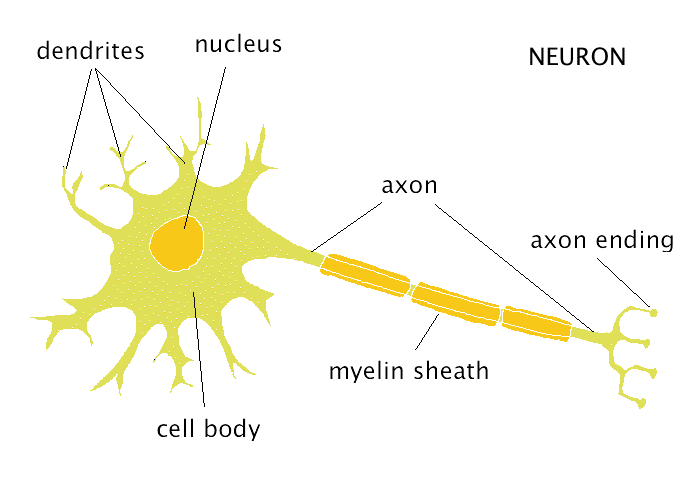
Figure 1: The structure of the neuron
The Reception and Transmission of Signals in the Neuron – the Generation of Action Potential
The body encounters hundreds of stimuli and pieces of information constantly. It is especially true nowadays: constant visual, auditory, and tactile (touch-related) stimuli challenge the sensory organs, in particular, the cells therein which relay stimuli, namely the receptors. These cells act as antennae by receiving signals and omitting unnecessary ones. A significant signal for the receptor launches electrical changes in the cell. Neurotransmitters are released, which alter the polarisation of the neuron which is connected to the receptor. As a result, action potential[1] is created, which is the basic unit of information transmission in the nervous system. The change in the electronic properties of the neuron occurs gradually through the axons, not instantaneously. This velocity of signal transmission would not suffice if one needs to act as promptly as it is required during the performance of a virtuoso passage or sudden breaking while driving. Thankfully, the organism has a mechanism in place for the economical and quick transmission of signals, which utilises glial cells (Szentágothai & Réthelyi, 2006). They wrap around the axon as insulation covers electrical wire but leave patches uncovered, thus enabling the saltatory conduction of the signal along the axon, which results in an extraordinarily fast transmission of information (Fonyó & Ligeti, 2008).
Communication between Neurons – the Synapse
To transmit the signal to another neuron, action potential is not enough, as electronic signal cannot pass through intercellular space. This is why neurotransmitters are needed, which activate receptors in a neighbouring neuron or muscle fibre. A long-term connection with continuing communication between the cells is called a synapse[2]. The functioning of neurons requires much energy, which is why people need a constant supply of glucose and oxygen, and cannot concentrate well in a stuffy room or if they are hungry and tired. Since the same applies to children, it is advisable to assess at the beginning of each music lesson as to how concentrated students can be on that day, and to adjust the tasks flexibly to their physical and mental state.
The Anatomy and Functional Division of the Nervous System
Based on functions, the nervous system is divided into visceral parts, which are autonomous and partially or not at all controllable, and somatic parts, which are under intentional control. Both visceral and somatic parts contain motor and sensory functions (Fonyó & Ligeti, 2008).
The nervous system comprises a central and peripheral section. The central nervous system consists of the brain and spinal cord, while the peripheral nervous system contains nerves (peripheral nerves, cranial nerves, spinal nerves) and ganglia, which transfer signals to organs and tissues. The brain and spinal cord can be considered as “conductors” of the entire body: they direct organs, glands, muscles constantly. The signals, however, are not limited to one direction: the body sends constant feedback to the centre (through hormones or nerves), which is then processed by the spinal cord and the brain to modulate and adjust the controlling signal as a function of the message (Szentágothai & Réthelyi, 2006). For example, the central nervous system may decide as to whether the most recent movement has been adequate and efficient, whether it should be repeated in the future, and to what extent it should be adjusted.
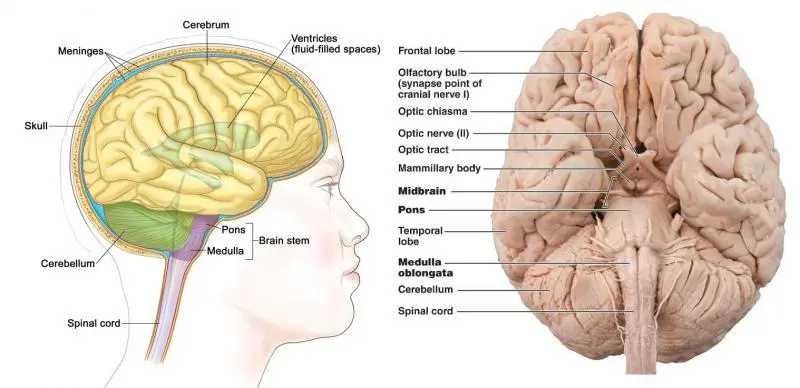
Figure 2: The structure of the central nervous system (lateral view of the head and neck region, the brain, and the spinal cord); inferior view of the brain with cranial nerves and the initial section of the spinal cord
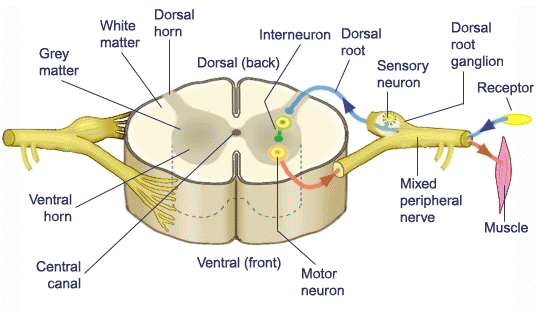
Figure 3: Cross-sectional depiction and structure of the spinal cord
Based on the characteristics of the tissue, the brain and spinal cord can be divided into grey matter and white matter. Nerve fibres of the white matter constitute nerve tracts, which connect distant neurons as wires. Tracts enable a signal for movement to reach from the spinal cord to the muscles, where the contraction occurs; parallelly, they also enable the relaxation of muscles initiated by the spinal cord. Subsequently, the muscle sends feedback to the brain about the success of the movement (adequate/inadequate) (Fonyó & Ligeti, 2008). Apparently, even a muscle contraction requires a complex system to be able to occur. The neuromuscular junction can be illustrated in a simplified way as a “reverse pianist” who holds all keys down at the same time and produces a sound only if the respective key is released. The central nervous system is invariably ready to transmit signals. In particular, large sections of the brain are stimulated when movements are learned, but hindering mechanisms can also emerge alongside stimulating impulses.
Certain muscle contractions can be considered reflex actions such as the patellar (knee-jerk) reflex or other reflexes which are present to avoid damaging stimuli (for example, we withdraw our hand if we touch something hot). Such reflexes occur unconsciously and are recognised only after the fact, which means that the movement is controlled at the spinal cord or the brainstem; in other words, it is not the cerebral cortex which sends the signal. Consequently, the cerebral cortex coordinates the cerebellum, the earlier originated brainstem (which is also referred to as the “reptilian brain” and contains the viscerally instrumental nuclei and the source of most cranial nerves), and the spinal cord. The latter two have separate functions which date back to earlier evolutionary stages (Fonyó & Ligeti, 2008).
The Cortical Representation of Motor and Sensory Functions
At a macroscopic level, the brain can be divided into areas from an evolutionary, morphological, and functional perspective, which are the following: cerebrum, diencephalon, cerebellum, and brainstem.
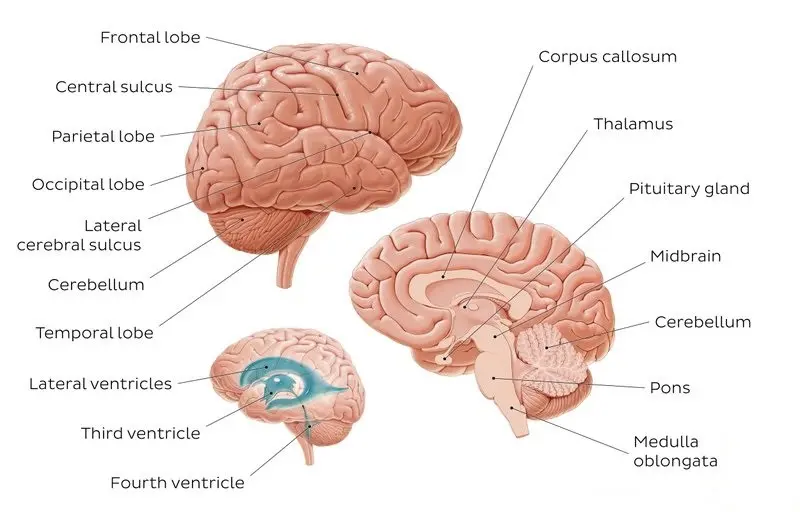
Figure 4: The macroscopic structure of the brain
Brain areas do not operate distinctly; instead, they communicate with each other through a complex network of nerve tracts. However, certain parts of the cerebral cortex (frontal lobe, parietal lobe, temporal lobe, occipital lobe), which are separated by gyri, each have a distinct function (motor function, sensory function, hearing, speech, speech recognition, sight).
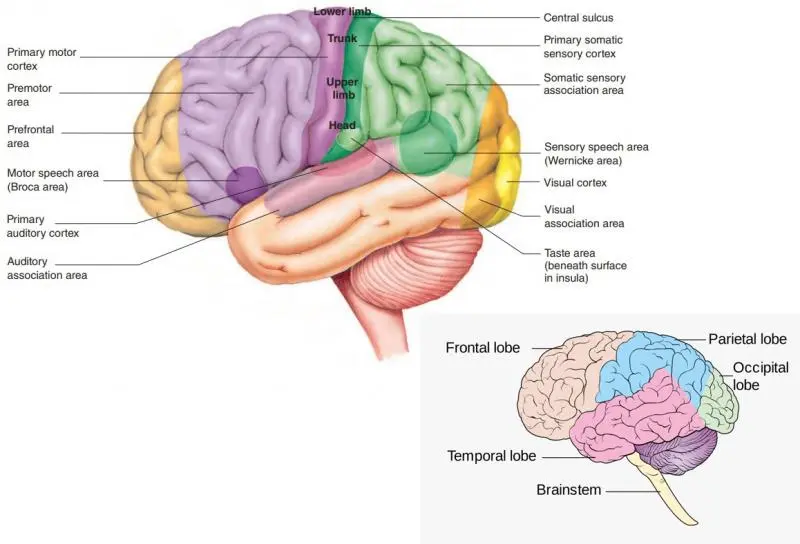
Figure 5: Lobes of the cerebral cortex and their functions
It was Brodmann[3] who first localised the functions of the cerebral cortex by identifying over fifty functions. It is widely known that the two hemispheres are specialised in different activities, even though they share similar Brodmann areas, but they also communicate constantly (Fonyó & Ligeti, 2008).
The left hemisphere is responsible for logical, rational, analytic thinking, whereas the right hemisphere is the area for creative, imaginative, holistic brain processes. To create a strong connection between the two hemispheres and achieve parity in their level of development, the abilities we control must be improved proportionately. It follows directly that children are advised to participate in some form of art education, which should be offered at just as a high standard as mathematics or foreign languages are taught (Hámori, 2005).
Centres of Motor Functions
Different areas of the brain and spinal cord are responsible for separate tasks with respect to movement mechanisms, as well.
- The spinal cord and the brainstem, which date back to relatively early evolutionary stages, control postural reflexes and the tone of antigravity muscles. (Although such movements are mostly based on mechanisms similar to reflexes, following the instructions of the “reptile brain”, they also contain various learned elements, which subsequently become automatic. These motor functions provide stability for voluntary movements, which are controlled primarily by the cerebellum, the diencephalon, and the cerebral cortex.)
- The primary motor cortex, which is responsible for learned movements and fine motor skills, is located at the gyri anterior to the central sulcus. The signal sent from the motor centre of the cortex on one side results in the movement of muscles on the other side of the body, due to crossing motor nerve tracts. In the primary motor cortex, the areas which control certain muscles of the body are located next to each other, with a few exceptions. The extent of the representation of a given muscle (that is, the number of neurons in the cortex) does not depend on the size of the muscle; instead, it is proportional to the level of refinement with which the muscle moves. This is illustrated effectively by the figure of the motor homunculus: while it is apparent that moving facial muscles and muscles of the hand requires a relatively large area in the brain, the movement of other muscles such as the muscles of the thigh is controlled by a smaller area (Fonyó & Ligeti, 2008). When people learn to play instruments, these areas are active constantly, which requires considerable energy.
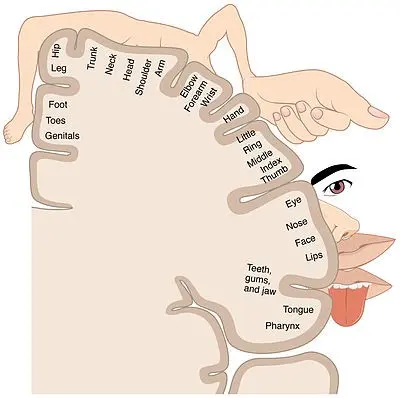
Figure 6: Motor homunculus
Anterior to the primary motor cortex lies the premotor cortex, which participates in the preparatory phase of the executed movements. It is responsible for gathering information which could affect the execution. All “data” arrive here from the cerebellum, whose responsibilities include motor coordination, and from the diencephalon, which plays a role in the emotional component of movements (Fonyó & Ligeti, 2008).
Centres of Sensory Function
It is important to mention the centres which control the sensory function because the execution of our movements is largely influenced by signals from our sensory systems. When playing instruments, the musical process is born as a result of executed movements and perceptions, which comprise information about the contact with the instrument, the produced sounds, and the visual image of the sheet music.
The somatosensory system provides information about signals which come from receptors on the surface of the body and on mucous membranes, about the position of limbs, about stimuli which could potentially damage the skin or certain internal organs, and about thermal contact on the skin. The stimuli from the receptors first reach the spinal cord, then progress through the medulla oblongata and various junctions to the somatosensory cortex, which is located at the cortical area posterior to the central sulcus.
The sensory information is processed initially at the primary sensory cortex, which is also divided into separate areas corresponding to certain parts of the body surface. In a similar way to the primary motor cortex, the representation of given body parts is not proportional to their size but to the density of receptors on them. For instance, the lips contain significantly more sensory receptors than the skin on the back, which is why practicing or playing wind instruments activates a sizable area of the sensory cortex. The figure of the sensory homunculus provides a great illustration to this (Fonyó & Ligeti, 2008).
The secondary somatosensory cortex is responsible for processing stimuli further. This cortical region receives input from the visual cortex and compares tactile and visual information (Fonyó & Ligeti, 2008). It has considerable significance for musicians: the visual perception of the sheet music, the tactile perception of the instrument, and the auditory perception of the produced sounds are processed at the same time, thus determining the quality of the performance.
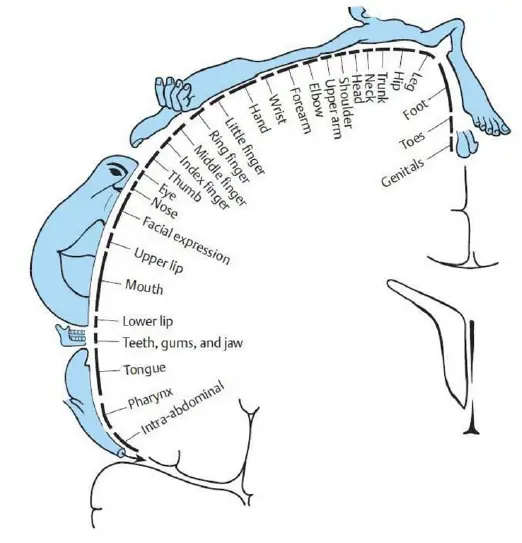
Figure 7: Sensory homunculus
In short, the somatosensory cortex has a significant role in practicing, learning, and coordinating movements.
The diencephalon is responsible for the emotional component of the sensory function through various tracts, so the cortical regions are also connected to the emotional function (Fonyó & Ligeti, 2008).
Stimuli from other senses (sight, hearing, sense of balance, olfactory and gustatory senses) activate different regions of the brain (occipital lobe, temporal lobe, olfactory bulb, diencephalon). This will not be discussed in further detail, but it is worthwhile to mention that the listed regions are connected to both the motor cortex and the somatosensory cortex through numerous nerve tracts, and also influence the motor function to some extent.
The Physiological Background of the Learning Process, the Memory, and the Execution of Movements
The Physiology of Executing Movements: the Pyramidal and Extrapyramidal Tracts
Depending on the motor outcome, the control over the execution of movements may occur in various ways. In general, however, the organism attempts to find an economical solution when executing movements, just as with any physiological function. The movements which define our posture and balance have been discussed previously. Nevertheless, certain learned and conscious movement sequences, even those which are in the process of being learned, are controlled by a superior centre, namely the motor cortex of the brain.
For such movements, signals from the motor cortex reach the skeletal muscles in two ways: through the pyramidal and extrapyramidal tracts. There are significant differences between the two tracts, which are also apparent from their distinct functions.
The pyramidal tract forms a synapse with the motor neuron of the given muscle in the brain or spinal cord, from where it proceeds with the signal to the neuromuscular junction, causing the muscle to contract. This tract controls movements which require attention and have not been practiced extensively. Each movement is directed from the cortex. Learning a new piece of music is a great example for this process. Other examples include children who, at the start of their music education, are able to play notes only distinctly.
By contrast, the extrapyramidal tract has various neural connections: it is joined to basal ganglia and to nuclei in the brainstem and the cerebellum, from where it receives information for regulating movements (about the sense of balance as well as vegetative and emotional functions). This system regulates learned, practiced, and muscle-intensive movements, which are initiated intentionally (unlike reflexes) but are executed automatically (Fonyó & Ligeti, 2008; Réthelyi, 2006).
While the brain is not familiar with a movement sequence, the pyramidal tract is in control; after sufficient practice, the extrapyramidal tract regulates. Evidence for this physiological phenomenon can be found by observing ourselves or music education students during practice.
Learning and Memory
In the nervous system, the responses induced by specific stimuli can change constantly; this is called the plasticity of the nervous system. Mental functions have both genetic and acquired components. Learning has the aim to have a given piece of information memorised in the long run (whatever it may be). The stimuli from the environment are screened as early as the sensory level, where useful information is distinguished from less important stimuli.
From sensory organs, relevant information reaches the sensory register first, which is also known as the sensory memory. The information is stored there for mere seconds and is transferred quickly to the short-term memory, which is able to store units of information (about seven of them) for about 20 seconds, after which it forgets them. Here, there are no synapses between neurons. After several repetitions and sufficient practice, information could be stored in the long-term memory. Some argue that the capacity of this memory is limitless.
Memory is often divided into two types: implicit (non-declarative) memory and explicit (declarative) memory. Implicit memory is neither conscious nor voluntary and often takes the form of behavioural, motor, and secretory actions. The definition includes the pedagogical concept of operant conditioning as well as several practiced activities. Implicit memory is utilised primarily in the adaptation to the environment (Fonyó & Ligeti, 2008).
Explicit memory comprises all declarative knowledge as well as content knowledge. It also compares and evaluates information. It is customary to distinguish between four stages of memory, namely in the following order: encoding, reinforcement, storage, and retrieval (Tóth, 2000).
Both memory types are influenced by emotional factors and motivation (partly because the cerebral regions responsible for memory also control the emotional state). This has been evidenced surely by all, including students in music education. For example, if there is a piece of music which children enjoy listening to, they are likelier to learn it with greater enthusiasm and to an elevated standard than they would in the case of some boring and monotonous etudes. Biology provides an explanation as to why teachers should not discount the relevance of emotional motivation and inclination during teaching.
Stages of Motor Development, the Development of Instrumental Skills, and Age-specific Characteristics
The complexity of the previously described learning processes and movement mechanisms illustrates the difficulties faced by those who, when they begin to learn an instrument, attempt to pick up new forms of movement. Visual (sheet music) and auditory (the produced sounds) stimuli need to be synchronised with their movements and perceptions of the instrument. Reading musical notation presupposes abstract cognitive abilities as well as the existence of a complex system of nerve tracts. Based on auditory experience, the “mind’s ear” could also develop, providing foundation for musical imagination. Evidently, this requires various synapses at the neural level and is the result of sizable investment in terms of time and energy. Based on all of the above, abilities and skills are characterised during the three stages of motor development in the following way:
- Initially, each movement is controlled separately by the cerebral cortex (through the pyramidal system), which requires the simultaneous operation of various regions of the brain. This is sometimes referred to as the irradiation phase of motor learning. During this period, activity occurs even at certain cortical sections which are not needed for the actual execution of the movement. As a result, unnecessary movements may accompany the primary one, with occasional stiffness, cramps, inadequate level of effort, even on the wrong side (for example, the muscles of the shoulder and neck may become stiff, the individual may experience constant blinking or tics, etc.). Both the continuity of movement and the adequate transition between motions are absent. Differences can be observed in the range of movement. At this stage, the rough motor coordination is shaped.
- In the second phase, the regions of the brain which are not essential in executing the movement are blocked. Consequently, both the continuity and consistency of movements improve, and inadequate transitions grow less frequent. The stiffness decreases, while movements also become more natural and are even executed occasionally with ease. The second stage is characterised by improving fine motor skills. While harmony is present, the movements are still closed, which is why musical expression cannot emerge yet.
- Subsequently, differentiated movement sequences materialise in the so-called stabilisation phase. The regulatory role of the central nervous system diminishes as the movements start to become automatic (that is, the extrapyramidal system takes over). The execution of movements occurs in an increasingly economical manner, while the acquired coordination skills are also utilised during instrumental play. This stage represents the dominance of fine motor skills and their implementation in varying circumstances. In particular, children become capable of interpreting and experiencing the musical message of a piece even in highly stressful situations such as a department concert.
Instrumental skills (that is, a collection of specific and complex actions and movements) are regarded highly developed if they are stable and steady, if they allow for flexibility, adaptability, and dynamism, and if they enable variations, which do not affect the essence, as well as concentrating on the factors of expression (Fonyó & Ligeti, 2008; Meizl, 1981).
To progress through all phases, one requires considerable time, the extent of which varies by individual. Teachers should bear in mind the developmental progress of the children’s nervous system and the movements sequences which children are able to learn at a specific age. Although some prodigies as young as 3 or 4 are capable of movements and intellectual performance which defy their age, most children in music education do not belong to this category. The road is quite long from reflex functions at early infancy through the gross motor learning of crawling and walking to learning fine motor skills such as drawing or writing. Children establish their relation to gravity and find their sense of balance through years of experience. In addition, more advanced neural structures and fine motor skills become fully developed only at the end of adolescence (Tulassay, 2018). Therefore, music teachers must be aware of students’ limitations and find creative and intuitive methodologies, thus enabling a level of instrumental play which could result in an enjoyable musical production.
Alternative Methods of Music Pedagogy and Body Therapy
Teachers of instruments should often consider making use of certain alternative methodologies, besides attempting to improve students’ motor coordination through instrumental skills. Employing these methods or using body therapy could help children in reinforcing perceptions of the instrument as well as in becoming broad-minded people (which is the goal of most alternative methodologies of music pedagogy, including the Kodály method) (Daragó, 2012). In addition, I believe that making students feel certain movement sequences intuitively would prevent several parafunctions of instrumental play. Furthermore, children nowadays do not encounter several forms of movement which had been natural previously, even though these could contribute to their success in the world by increasing the development, flexibility, and adaptiveness of the nervous system. Alternative methodologies of music pedagogy place emphasis on improvisation as well as on the development of connections between movement and musical processes (Szőnyi, 1988).
Among methods applicable for the youngest generation (even as early as pre-education), the Dalcroze method and the Kokas method should be highlighted. Dalcroze eurythmics establishes children’s sense of rhythm through perceptions of the body, which it also uses, alongside auditory experiences, as a foundation for knowledge about music theory. The methodology is employed most frequently in Hungarian Waldorf schools (Dalcrose, 1967; Fazekas, 2015).
The Kokas method can be considered as a universal artistic approach and also as a great resource for development pedagogy (Kokas, 1972).
Even older participants of music education can derive novel experiences, creativity, and improvisational inspiration from the Orff method and László Stachó’s methodology of practice (Szőnyi, 1988).
The methodology of practice proposed by László Stachó can be employed successfully among higher cohorts of secondary vocational music education and in tertiary music education. The method lies in anticipating instrument-related perceptions and movements, which is achieved best by making students develop an intuition during rubato play or improvisation (Stachó, 2017).
Various methods provide help with respect to preserving health, body therapy, and developing musical intuitions.
Among the most popular methodologies, we find the Kovács method, which aims to educate towards a “musical lifestyle”. It incorporates short movement breaks in the process of practice. The use of the method as a preventive measure among students in primary music education is advised to avoid the development of inappropriate functions (Pálfi, 2017).
The Alexander technique (see: http://www.alexander-mozgas.hu) and the Feldenkreis method (see: www.feldenkraisinstitut.at) provide great tools for shaping body consciousness and treating existing malfunctions.
An even broader approach is offered by the course titled Musicality of Movement, which was developed for musicians by Virág Dezső, dance artist in Amsterdam. The course is more than a mere “method” as it is more complex. It can be interpreted as a universal artwork, which aims to shut off the brain and the consciousness, to establish and experience trust in one’s own body and in gravity, to focus on the parallels between movements and musical processes, to concentrate on internal perceptions, and to experience the importance of stage movement and stage presence (see: www.musicalityofmovement.com). In Hungary, the course is offered as an elective at the Faculty of Music of the University of Debrecen and at the Young Musicians’ Summer Academy.
The Rolfing body therapy (which is a sort of massage and movement therapy system), developed by Ida Rolf, is based partly on similar principles. According to the principle of the therapy, restoring the natural and harmonic movement of the body is possible through the integrity of the connective tissue, with special regard to the effect of gravity on the body and to the restoration of trust in body movements and in gravity. The method could prove useful in avoiding inadequate instrumental movements and in restoring correct posture. It is popularised in Hungary by Sándor Révész (Révész, 2017).
The Methodological Application of Modern or Extended Flute Techniques from Primary to Tertiary Music Education
Invariably, the classical sound produced by the flute is aimed to be proportional by evoking a natural and light impression, but sometimes it proves insufficient for creating extreme dynamics, unusual tones, and extraordinary musical effects. The tools for novel musical expression, which are only limited by the characteristics of the instrument and by the composers’ and performers’ practice, creativity, and fantasy, have expanded significantly in recent years. The open approach which accepts existing techniques but incentivises the artist to experiment in a curious manner has resulted in a more varied technical and musical toolbox.
István Matuz has done pioneering work in making use of the possibilities provided by the Boehm flute and in exploring the structural and acoustic characteristics of the instrument.
The expression “modern flute technique” is increasingly inadequate. Employing technical tools which are included in the term have become prevalent; mastering them is almost compulsory for any well-prepared flautist familiar with the instrument and its history. Katalin Nagy offers the following explanation in her doctoral thesis: “… it is increasingly true that the most adequate description of these techniques is the term “extended techniques”, in which “extended” stands for a dynamic and constant expansion” (Nagy, 2010).
It is worthwhile to explore the extended techniques which are necessary for producing and mastering novel sounds. In addition, it is important to investigate their effect on classical sound production as well as the applicability of their elements in establishing basic instrumental skills. In general, beginners are unbiased, enthusiastic, and experimental about the discovery of unknown areas, which could happen either individually or under a well-trained teacher’s supervision. It is advisable to support children in such endeavours for two reasons: first, “the joy of discovery”, an important motivational factor in pedagogy, could disappear if teachers restrict possibilities to areas, sounds, and sound effects which are associated conventionally with the flute; second, avoiding extended techniques would mean giving up methodological tools which can be applied just as beneficially in classical sound production or in finger and tongue techniques.
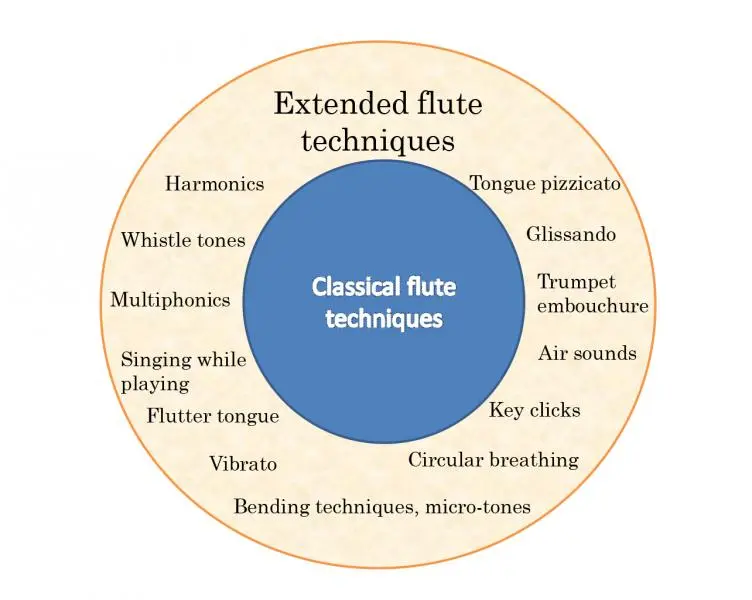
Figure 8: Extended flute techniques
Bending Technique, Micro-tones
Increasingly, composers from the world of modern music employ quarter tone scales in their compositions, but even smaller intervals called micro-tones are also common. In other words, contemporary composers are not content with using the twelve semitones only and often venture to the field of even smaller pitch differences. While the quarter tone scale consists of notes which divide semitones into two equal parts, micro-tones represent even smaller distances between the notes, which are performed according to the composer’s requirements.

Figure 9: Notation of quarter tones in Barnabás Dukay’s flute sonata
titled “The Burning Flame of Stone”
Slight differences in pitch can be achieved by turning the flute inward or outward, or by nodding the head, which alters the distance between the upper lip and the plate, the air angle, and, consequently, the pitch. Generally, limiting the sound (by turning the hole inward) could lower the pitch by as much as a fourth, while making the pitch higher (by turning the hole outward) could produce a difference of a quarter tone only.
If we wish to achieve a slight difference compared to a specific pitch, which is smaller than a semitone, namely a quarter tone or micro-tone, usually we must employ alternative fingerings. This could happen through muted fingerings (additional closing, that is, closing the row)[4], utilising the small apertures on the key, and overblowing notes, whereby we open aperture(s) next to the adequate joint to produce harmonics.
The use of these tones is likely to result in unusual tones (which represents an extraordinary and playful experience for beginners by itself), could make the ability for corrections in intonation better and more flexible, and might sensitise and refine the hearing.

Excerpt 1: Micro-notes
Glissando
Glissando means a continuous slide between two specific notes. Therefore, the desired pitch is reached from the starting point in an uninterrupted manner, by touching (gliding through) every note in between.
Continuous sliding between notes is not common among flautists, mainly due to the nature of the instrument: keys make the execution highly demanding.
The desired effect can be achieved by turning the instrument in the same manner as with micro-tones. However, gliding between large intervals requires the fingers to slide along the keys. This requires moving the hands in a way whereby the keys are opened and closed gradually (that is, not resembling gears). Ideally, the fingers should be a couple of holes ahead of the end of each section, gradually opening or closing multiple apertures at the same time, depending on the direction of the slide. Producing an uninterrupted glide requires an open-hole flute almost invariably (Ittzés, 2004). (Example: Zoltán Gyöngyössy: Pearls – Hommage à Barnabás Dukay.)
In a similar way to bending techniques, practicing and mastering glissando methods could prove to be a great way to become familiar with various tones, to create and govern the adequate intonation, hearing, and flexible mouth position, and to improve motor coordination even at the primary level.

Excerpt 2: Glissando
Vibrato
Vibrato is the constant, mostly uniform, periodic, and slight change of a musical note from a specific frequency to another pitch, which is either higher or lower than the original. Acoustically, the technique regulates the flow of air: periodic variation in the pitch is achieved by an oscillating inflow of air.
On the flute, it is possible to differentiate the short-amplitude (dense) vibrato from the long-amplitude one. To produce gradually accelerating or decelerating vibrato, the player needs to be in control of the basic variants of the technique.
Whereas previously it was the performer’s responsibility to decide whether to use vibrato or not, which could reflect the artist’s personality directly and contribute to a deeper understanding of the performance, nowadays composers tend to prescribe it. In his sonata for solo flute, Barnabás Dukay even attempts a more precise notation which reflects the pace and amplitude of the vibrato; in addition, he also employs the notation senza vibrato multiple times.

Figure 10. Notation of vibrato in a sonata for solo flute
Teaching vibrato is only possible if the student has a sound foundation in respiration and is able to produce developed sounds. Learning and mastering vibrato, however, can be used efficiently in illustrating the role of the diaphragm and in relaxing the larynx and the throat.
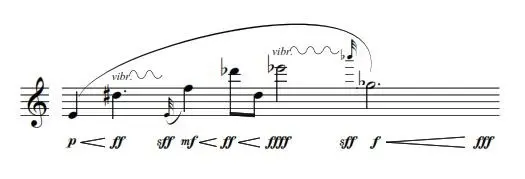
Excerpt 3: Vibrato
Harmonics
Music teachers should introduce their students to the system of harmonics as early as possible as this acoustic phenomenon is a major determinant of flute play. In my experience, even 10 or 12-year-olds are capable of understanding the notion that natural harmonics are integer multiples of the fundamental frequency. Sometimes harmonics are also referred to as partials as they coexist with the fundamental note and are integral parts thereof. Their number and relation to the fundamental note affect the tone of the produced sound.
Practicing harmonics is a great exercise to teach the conscious control of air speed. There are two possibilities for this:
- increasing the speed and pressure of the air;
- tightening the inside of the mouth or the lips.
In the first case, the tone and quality of the sound remain unchanged, but its intensity increases due to the larger quantity of air. In the second case, playing a higher note results in a somewhat quieter sound because a greater air speed is accompanied with the outflow of a diminished amount of air (due to the lip barrier) (Ittzés, 2004). In reality, the two parameters are often modified simultaneously; however, it is still worthwhile to experiment with them separately during practice.
Through knowing and mastering the system of harmonics, players’ hearings accustom to natural tuning, while their embouchure could become more flexible, with a smoother legato play. (Example: sound exercise from Peter-Lukas Graf’s book titled Check-up – 20 basic studies for flute.)
Whistle Tones
Whistle tones follow the rules of natural harmonics. Although they are very gentle sounds, their pitch can be quite high: partials at the 3rd or 4th octave resemble whistles. They are special because actual standing waves and resonance are not generated in the instrument body, which is why whistle tones require less energy to produce than usual. Since volume is proportional to the amount of air, whistle tones need limited airflow to appear. For this, the mouth should be widened as far as possible, the lips should be opened unusually, the tongue should be pressed down extraordinarily, and the instruments needs to be tilted slightly. Sounds produced this way can be separated; that is, they can be played without perceiving the fundamental note. However, they cannot be stabilised as easily as traditional overblows: there are almost constant random changes to neighbouring partials.

Excerpt 4: Whistle tones
Whistle tones are usually notated by a rhombus on the staves or circles above the staves, with an optional W.T. notation for whistle tones. (Example: Sakura, sakura by István Matuz.)
If players find and grasp such effects, they become used to a high level of control which is difficult to obtain through traditional embouchure. At the same time, an unusually strong sense of support is needed for the slow flow of air and for the stabilisation of pressure.
Flatter Tongue
The sound-modifying technique, which is called Flatter Zunge in German and frullato in Italian, was first used by artists and composers in the first half of the 19th century. It has two varieties, in close connection with the mother tongue and individual abilities: the first consists of the tremolo-like rolling of the “r”, while the second comprises a soft “gargling” produced by the uvula in the back (Ittzés, 2004). In both cases, the outflow of air is accompanied by a constant and prolonged “r” sound, which alters the flow of air into the flute and, consequently, the produced sound. (Examples: Chant de Linos by Jolivet, Pearls – Hommage à Márta Kurtág and György Kurtág by Gyöngyössy.)
Practicing the technique has the advantage that it could result in a more open, gentle, and round lip position, which is required for stable and controlled airflow. Using flatter tongue in the back is a great and useful exercise to prevent tenseness and strain in the throat.

Excerpt 5: Flatter tongue
Air Sounds
This modification produces a wind-like sound, which is partially mixed with the frequency of the fundamental note. This requires the player to form a consonant (“s” or “f”) at a distance from the opposing plate and to pressure air into the flute through a sigh-like exhale. It is up to the player or the composer to determine the amount of noise which accompanies the pure note.
Practicing air sounds is a useful and efficient tool for both the sense of support (due to the constant or changing air pressure) and the flexibility of embouchure.

Excerpt 6: Air sounds
Tongue Pizzicato
The technique of tongue pizzicato or tongue slap, which is common among woodwind players, produces a sound similar to pizzicato on string instruments. First, the tongue is pressed at the back of the teeth, accompanied by significant air pressure. Then, the tongue is released suddenly, the flow of air is stopped, and only the air in the mouth reaches the instrument; as a result, a secco, percussive, non-resonated sound is produced. (Example: Pearls – Hommage à József Sári by Gyöngyössy.)

Excerpt 7: Tongue pizzicato (pizz/slap)
The technique strengthens the muscles of the tongue, accelerates and relaxes the movement of the tongue, and helps in adjusting the exact posture of the mouth with respect to the instrument as well as the tongue position. It is also useful for practicing double tongue.
Key Clicks
Key clicks are sounds produced by the strong closing of the keys, which resemble percussion instruments and have a specific pitch. Composers often prescribe key clicks at the same time as a note is initiated or alongside tongue pizzicato. Usually it is notated by replacing the note head with an x sign. (Example: Sequenza by Berio.)
Learning key clicks adequately makes fingerings more precise and the moment of closing the keys more accurate, improves the synchronisation of fingers, and accelerates the execution of movements which are necessary for changes in position.

Excerpt 8: Key clicks
Singing While Playing
It is possible to produce a sound with the vocal cords at the same time as the flute is played (which is also common in instrumental folk music). The flow of air through the larynx first creates resonation in the vocal cords, then it produces a sound on the flute once it reaches its body.
Singing while playing improves polyphonic thinking and enables the separation of the flute and sung melodies to a significant degree, which, however, can only be achieved gradually through consistent practice. (Example: Sakura, sakura by Matuz.)
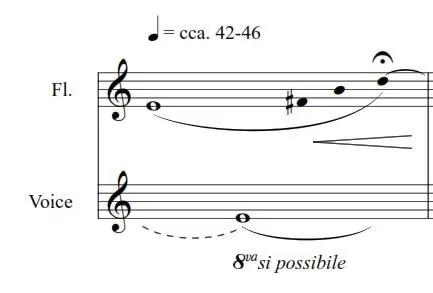
Excerpt 9: Singing while playing
Trumpet Embouchure
The technique emulates the embouchure of brass instruments, whereby the player blows into the hole of the flute while the lips seal the hole completely (which can be done even on flutes without the head joint), thus producing a deep and full-toned sound, which resembles the tárogató.
Employing the technique is beneficial for the tone of the lip muscles and incentivises students to experiment playfully. Even a short practice session could make lower registers shinier. However, overuse might result in the significant exhaustion of embouchure muscles.

Excerpt 10: Trumpet embouchure
Pseudo-multiphonics, Multiphonics
Pseudo-multiphonics
Although it is often considered evident that the flute is a monophonic instrument, it is not difficult to prove that strict monophony does not exist. This is mainly because fundamental notes are always accompanied by partials. The system of harmonics is composed of integer multiples of the fundamental frequency. Usually, human hearing perceives harmonics which accompany the fundamental note as a tone, but easy-to-perceive harmonics can be separated with relative ease. If the energy of sound production, that is, the air speed is increased only gradually, change between different partials does not resemble a jump. There exists a band between adjacent partials in which both can be heard at the same time. In other words, the same fingering may generate multiple natural harmonics on the body of the flute, which is sometimes referred to as pseudo-multiphonics.
Multiphonics
Special fingerings (that is, covering additional hole(s) after a specific open key) may produce extraordinary body proportions on the flute, resulting in a distinct system of harmonics. Consequently, pitches which are not in the same family of harmonics may be produced alongside their (modified) partials, thus creating a distorted system of harmonics with novel ranges. Practicing multiphonics requires learning new combinations of fingerings, which are not employed in classical play, and could result in a conscious and controlled fingering technique. In addition, utilising the small apertures on the keys could be advantageous in achieving a relaxed and tensionless sensation. The lip and respiratory muscles used during the play of multiphonics are also essential for learning movement mechanisms of classical sound production.
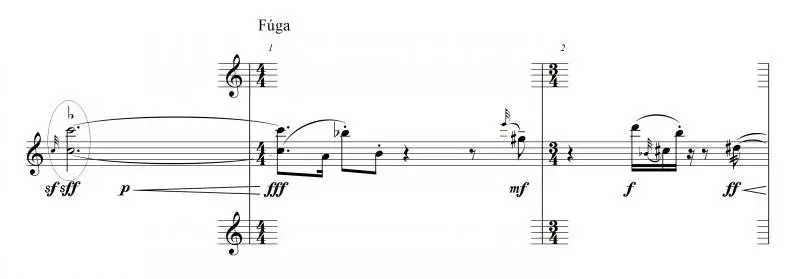

Excerpt 11: Multiphonics
Circular Breathing – Parallel Exhaling
The muscles of our mouth are created in a way that the barrier between the mouth and larynx, namely the oropharyngeal isthmus, can be sealed hermetically with the muscles of the tongue, soft palate, and pharyngeal arches. (An example for this is the pronunciation of the “k” sound.) In addition, the volume of the mouth can be further reduced using facial and tongue muscles. That is, several decilitres of air can be pressed out of the mouth independently of the lung and respiratory functions. Consequently, it is feasible to press the air out of the mouth and inhale through the nose and respiratory tracts to the alveoli of the lung at the same time.
In essence, this is a simultaneous airflow in the mouth and nose with opposite directions. Besides the opposite airflow through the mouth and nose, circular breathing also permits simultaneous exhaling through both the nose and mouth, which resembles a deflating valve to remove unused air (Becsky, 2003).
The use of both circular breathing and parallel exhaling solves the problem of missing or unused and remaining air, provides repeated ventilation for the whole body, and results in a calm and unconcerned state of mind due to fresh oxygen. Furthermore, employing the technique enables the synchronisation and adaptation of the body to the structure of the musical piece as well as a comfortable, enjoyable, and balanced sense.
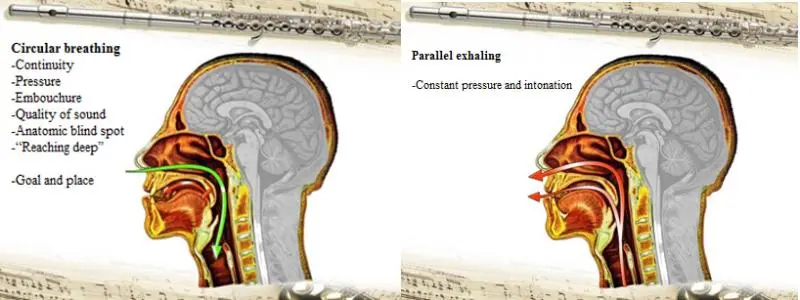
Figure 11: Circular breathing and parallel exhaling
References
- Bárdos Adrienne (2004): A Feldenkrais módszer alkalmazása különböző célcsoportokban [Application of the Feldenkrais Method in Different Target Groups.]. https://docplayer.hu/2051192-A-feldenkrais-modszer-alkalmazasa-kulonbozo-celcsoportokban-tanulmany-irta-bardos-adrienne-2004.html
- Becsky Áron, Dr. (2003): Az adaptálható fúvóslégzés [Adaptive Breathing on Wind Instruments.]. Parlando, 45. 4. 8–21.
- Daragó Rita Laura (2012): Életreform és zenepedagógia. A 20. század alternatív zeneoktatási módszereinek életreform-vonatkozásai [Life Reform and Music Pedagogy. Life Reform Aspects of Alternative Music Teaching Methods of the 20th Century.]. Iskolakultúra, 22. 5. 3–10.
- Dalcrose, Emile Jaques (1967): Rithm Music & Education. The Dalcrose Society, London.
- Fazekas Alexandra (2015): Alternatív zenepedagógiai irányzatok a XX. században [Alternative Music Pedagogical Trends in the 20th Century]. Thesis. Manuscript. Miskolci Egyetem BBZI, Miskolc.
- Fonyó Attila & Ligeti Erzsébet (2008): Az orvosi élettan tankönyve [A Textbook of Medical Physiology]. Medicina Kiadó, Budapest.
- Hámori József (2005): Az emberi agy aszimmetriái [Asymmetries of the Human Brain]. Dialog Campus Kiadó, Budapest.
- Ittzés Gergely (2004): A modern fuvolatechnika módszertani alkalmazása [Methodological Application of Modern Flute Technology]. Fuvolaszó, XIII. 41. 26–29.
- Kokas Klára (1972): Képességfejlesztés zenei neveléssel [Skill Development through Music Education]. Zeneműkiadó, Budapest.
- Meizl Ferenc (1981, ed.): Fafúvós hangszerek tanításának módszertana [Methodology of Teaching Woodwind Instruments]. Tankönyvkiadó, Budapest.
- Nagy Katalin (2010): A kiterjesztett fuvolatechnika. A fuvolajáték új hangzáslehetőségeinek áttekintése technikai, akusztikai, pedagógiai és zeneirodalmi szempontból [The Extended Flute Techniques. New Sounding Possibilities of the Flute: technical, acoustical, pedagogical aspects involving compositional overview]. Doctoral thesis. Liszt Ferenc Zeneművészeti Egyetem, Budapest.)
- Pálfi Zsuzsanna Mária (2017): A Kovács-módszer helye, szerepe, jelentősége, hatása a kórusiskola, az osztály, és az egyén nevelési, oktatási folyamatában [The Place, Role, Significance and Impact of the Kovács Method in the Educational Process of the Choir School, the Class and the Individual]. Szakdolgozat pedagógus szakvizsgához., Parlando, http://www.parlando.hu/2017/2017-5/Palfi_Zsuzsanna-Kovacs-modszer.pdf
- Stachó László (2017): Practice Methodology: A powerful tool in music performance education. In: Aaron Williamon, Petur Jónasson (eds.): Abstracts of the International Symposium on Performance Science (ISPS). Iceland Academy of the Arts, Reykjavik, 205.
- Szőnyi Erzsébet (1988): Zenei nevelési irányzatok a XX. században [Trends in Music Education in the 20th Century]. Tankönyvkiadó Vállalat, Budapest.
- Szentágothai János és Réthelyi Miklós (2006): Funkcionális anatómia [Functional Anatomy]. Medicina Kiadó, Budapest.
- Révész Sándor (2017): Apeiron. Kétely és bizalom – a szomatikus fordulat. A gravitáció természetéről. Az emberi test és a mentális háttérfolyamatok reflexiófelületei [Apeiron. Doubt and Confidence – the Somatic Turn. On the Nature of Gravity. Reflection Surfaces of the Human Body and Mental Background Processes]. Self-published.
- Tóth László (2000): Pszichológia a tanításban [Psychology in Teaching]. Pedellus Tankönyvkiadó, Debrecen.
- Tulassay Tivadar (2018, ed.): Klinikai gyermekgyógyászat [Clinical Pediatrics]. Medicina Kiadó, Budapest.
Websites
- Alexander-technique education and therapy: http://www.alexander-mozgas.hu
- Feldenkrais Institut Wien: www.feldenkraisinstitut.at
- MoM / Musicality of Movement: www.musicalityofmovement.com
[1] Action potential: an electronic signal which travels down a cell during its repolarisation (change in the flow of sodium ions through the membrane) and is based on the principle of all or nothing (if the stimulus reaches the threshold potential, the action potential is triggered).
[2] The emergence of a synapse presupposes a change in the gene expression of the neuron and the synthesis of a new protein (neurotransmitter).
[3] Korbinian Brodmann (1868-1918) was a German neurologist, who identified 52 separable areas of the cerebral cortex using characteristics of the tissue and their function.
[4] Closing the row refers to keeping all keys after the first open hole in a closed position.